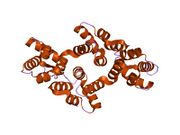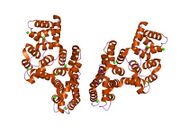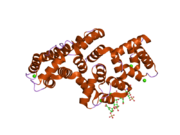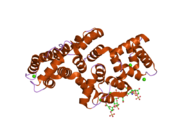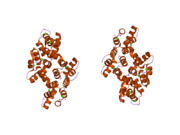آنكسين إيه 2
آنكسين إيه 2 (Annexin A2)، يُعرف أيضاً باسم آنكسين 2 (annexin II)، هو پروتين في البشر يرمزه الجين ANXA2.[4]
يشارك آنكسين 2 في العمليات الخلوية المتنوعة مثل حركية الخلية (خاصةً الخلايا الظهارية)، وربط المجمعات الپروتينية المرتبطة بغشاء الهيكل الخلوي الأكتيني، الالتقام الخلوي، انحلال الفبرين، تشكيل القنوات الأيونية، وتفاعلات المصفوفة الخلوية.
وهو پروتين مرتبط بالدهون الفوسفورية يعتمد على الكالسيوم وتتمثل وظيفته في المساعدة في تنظيم الإخراج الخلوي من الپروتينات داخل الخلايا إلى النطاق خارج الخلية. آنكسين 2 هو پروتين متعدد النمط الظاهري مما يعني أن وظيفته تعتمد على المكان والزمان في الجسم.
الجين
جين ANXA2، الذي يقع في 15q22.2، يحتوي على ثلاثة جينات كاذبة موجودة في الكروموسومات 4 و9 و10 على التوالي. عُثر على متغيرات نسخ متعددة مقسمة بدلاً من ذلك ترميز أشكالًا إسوية مختلفة لهذا الجين.[5]
الوظيفة
هذا الپروتين هو عضو في عائلة الآنكسينات. يلعب أعضاء عائلة الپروتين المرتبط بالدهون الفوفسورية المعتمدة على الكالسيوم دورًا في تنظيم النمو الخلوي ومسارات نقل الإشارة. يعمل هذا الپروتين كعامل أوتوكرين يزيد من تكوين ناقضات العظم والارتشاف العظمي.[5] تحد التنظيم اللاجيني لآنكسين 2 كعامل محدد رئيسي لتحول اللُحمة المتوسطة في أورام المخ.[6] يساهم نقص جين ANXA2 الأمومي في الغزو السطحي التساقطي بواسطة خلايا الأرومة الخلوية المغذية للمشيمية. تسلط هذه النتائج الضوء على مساهمة الأمهات في التسبب في تسمم الحمل.[7]
كما اقترح أن آنكسين 2 يعمل داخل الخلية على فرز الجسيمات الداخلية وخارج الخلية في التفاعلات المناعة للتخثر.
التفاعلات
يظهر آنكسين 2 تفاعلاً مع الپروهيبتين،[8] CEACAM1،[9] S100A10،[10][11] PCNA،[12] العامل إتش المتمم،[13] وعدد من العوامل الڤيروسية بما في ذلك HPV16 capsid protein L2 الأصغر.[14][15]
انظر أيضاً
المصادر
- ^ أ ب ت GRCm38: Ensembl release 89: ENSMUSG00000032231 - Ensembl, May 2017
- ^ "Human PubMed Reference:". National Center for Biotechnology Information, U.S. National Library of Medicine.
- ^ "Mouse PubMed Reference:". National Center for Biotechnology Information, U.S. National Library of Medicine.
- ^ Takahashi S, Reddy SV, Chirgwin JM, Devlin R, Haipek C, Anderson J, Roodman GD (November 1994). "Cloning and identification of annexin II as an autocrine/paracrine factor that increases osteoclast formation and bone resorption". The Journal of Biological Chemistry. 269 (46): 28696–28701. doi:10.1016/S0021-9258(19)61961-7. PMID 7961821.
- ^ أ ب "Entrez Gene: ANXA2 annexin A2".
- ^ Kling T, Ferrarese R, Ó hAilín D, Johansson P, Heiland DH, Dai F, et al. (October 2016). "Integrative Modeling Reveals Annexin A2-mediated Epigenetic Control of Mesenchymal Glioblastoma". EBioMedicine. 12: 72–85. doi:10.1016/j.ebiom.2016.08.050. PMC 5078587. PMID 27667176.
- ^ Ng SW, Norwitz GA, Pavlicev M, Tilburgs T, Simón C, Norwitz ER (June 2020). "Endometrial Decidualization: The Primary Driver of Pregnancy Health". International Journal of Molecular Sciences. 21 (11): 4092. doi:10.3390/ijms21114092. PMC 7312091. PMID 32521725.
- ^ Bacher S, Achatz G, Schmitz ML, Lamers MC (December 2002). "Prohibitin and prohibitone are contained in high-molecular weight complexes and interact with alpha-actinin and annexin A2". Biochimie. 84 (12): 1207–1220. doi:10.1016/S0300-9084(02)00027-5. PMID 12628297.
- ^ Kirshner J, Schumann D, Shively JE (December 2003). "CEACAM1, a cell-cell adhesion molecule, directly associates with annexin II in a three-dimensional model of mammary morphogenesis". The Journal of Biological Chemistry. 278 (50): 50338–50345. doi:10.1074/jbc.M309115200. PMID 14522961.
- ^ Réty S, Sopkova J, Renouard M, Osterloh D, Gerke V, Tabaries S, et al. (January 1999). "The crystal structure of a complex of p11 with the annexin II N-terminal peptide". Nature Structural Biology. 6 (1): 89–95. doi:10.1038/4965. PMID 9886297. S2CID 26400923.
- ^ He KL, Deora AB, Xiong H, Ling Q, Weksler BB, Niesvizky R, Hajjar KA (July 2008). "Endothelial cell annexin A2 regulates polyubiquitination and degradation of its binding partner S100A10/p11". The Journal of Biological Chemistry. 283 (28): 19192–19200. doi:10.1074/jbc.M800100200. PMC 2443646. PMID 18434302.
- ^ Ohta S, Shiomi Y, Sugimoto K, Obuse C, Tsurimoto T (October 2002). "A proteomics approach to identify proliferating cell nuclear antigen (PCNA)-binding proteins in human cell lysates. Identification of the human CHL12/RFCs2-5 complex as a novel PCNA-binding protein". The Journal of Biological Chemistry. 277 (43): 40362–40367. doi:10.1074/jbc.M206194200. PMID 12171929.
- ^ Leffler J, Herbert AP, Norström E, Schmidt CQ, Barlow PN, Blom AM, Martin M (February 2010). "Annexin-II, DNA, and histones serve as factor H ligands on the surface of apoptotic cells". The Journal of Biological Chemistry. 285 (6): 3766–3776. doi:10.1074/jbc.M109.045427. PMC 2823518. PMID 19951950.
- ^ Woodham AW, Da Silva DM, Skeate JG, Raff AB, Ambroso MR, Brand HE, et al. (2012). "The S100A10 subunit of the annexin A2 heterotetramer facilitates L2-mediated human papillomavirus infection". PLOS ONE. 7 (8): e43519. Bibcode:2012PLoSO...743519W. doi:10.1371/journal.pone.0043519. PMC 3425544. PMID 22927980.
- ^ Woodham AW, Raff AB, Raff LM, Da Silva DM, Yan L, Skeate JG, et al. (May 2014). "Inhibition of Langerhans cell maturation by human papillomavirus type 16: a novel role for the annexin A2 heterotetramer in immune suppression". Journal of Immunology. 192 (10): 4748–4757. doi:10.4049/jimmunol.1303190. PMC 4019435. PMID 24719459.
قراءات إضافية
- Kwon M, MacLeod TJ, Zhang Y, Waisman DM (January 2005). "S100A10, annexin A2, and annexin a2 heterotetramer as candidate plasminogen receptors". Frontiers in Bioscience. 10 (1–3): 300–325. doi:10.2741/1529. PMID 15574370.
- Babiychuk EB, Draeger A (June 2006). "Regulation of ecto-5'-nucleotidase activity via Ca2+-dependent, annexin 2-mediated membrane rearrangement?". Biochemical Society Transactions. 34 (Pt 3): 374–376. doi:10.1042/BST0340374. PMID 16709165.
- Bohn E, Gerke V, Kresse H, Löffler BM, Kunze H (January 1992). "Annexin II inhibits calcium-dependent phospholipase A1 and lysophospholipase but not triacyl glycerol lipase activities of rat liver hepatic lipase". FEBS Letters. 296 (3): 237–240. doi:10.1016/0014-5793(92)80294-Q. PMID 1531641. S2CID 19633878.
- Dawson SJ, White LA (May 1992). "Treatment of Haemophilus aphrophilus endocarditis with ciprofloxacin". The Journal of Infection. 24 (3): 317–320. doi:10.1016/S0163-4453(05)80037-4. PMID 1602151.
- Jindal HK, Chaney WG, Anderson CW, Davis RG, Vishwanatha JK (March 1991). "The protein-tyrosine kinase substrate, calpactin I heavy chain (p36), is part of the primer recognition protein complex that interacts with DNA polymerase alpha". The Journal of Biological Chemistry. 266 (8): 5169–5176. doi:10.1016/S0021-9258(19)67770-7. PMID 1825830.
- Filipek A, Gerke V, Weber K, Kuźnicki J (February 1991). "Characterization of the cell-cycle-regulated protein calcyclin from Ehrlich ascites tumor cells. Identification of two binding proteins obtained by Ca2(+)-dependent affinity chromatography". European Journal of Biochemistry. 195 (3): 795–800. doi:10.1111/j.1432-1033.1991.tb15768.x. PMID 1999197.
- Becker T, Weber K, Johnsson N (December 1990). "Protein-protein recognition via short amphiphilic helices; a mutational analysis of the binding site of annexin II for p11". The EMBO Journal. 9 (13): 4207–4213. doi:10.1002/j.1460-2075.1990.tb07868.x. PMC 552202. PMID 2148288.
- Spano F, Raugei G, Palla E, Colella C, Melli M (November 1990). "Characterization of the human lipocortin-2-encoding multigene family: its structure suggests the existence of a short amino acid unit undergoing duplication". Gene. 95 (2): 243–251. doi:10.1016/0378-1119(90)90367-Z. PMID 2174397.
- Johnsson N, Johnsson K, Weber K (August 1988). "A discontinuous epitope on p36, the major substrate of src tyrosine-protein-kinase, brings the phosphorylation site into the neighbourhood of a consensus sequence for Ca2+/lipid-binding proteins". FEBS Letters. 236 (1): 201–204. doi:10.1016/0014-5793(88)80314-4. PMID 2456953.
- Gould KL, Woodgett JR, Isacke CM, Hunter T (July 1986). "The protein-tyrosine kinase substrate p36 is also a substrate for protein kinase C in vitro and in vivo". Molecular and Cellular Biology. 6 (7): 2738–2744. doi:10.1128/mcb.6.7.2738. PMC 367834. PMID 2946940.
- Huebner K, Cannizzaro LA, Frey AZ, Hecht BK, Hecht F, Croce CM, Wallner BP (May 1988). "Chromosomal localization of the human genes for lipocortin I and lipocortin II". Oncogene Research. 2 (4): 299–310. PMID 2969496.
- Huang KS, Wallner BP, Mattaliano RJ, Tizard R, Burne C, Frey A, et al. (July 1986). "Two human 35 kd inhibitors of phospholipase A2 are related to substrates of pp60v-src and of the epidermal growth factor receptor/kinase". Cell. 46 (2): 191–199. doi:10.1016/0092-8674(86)90736-1. PMID 3013422. S2CID 24557024.
- Buday L, Egan SE, Rodriguez Viciana P, Cantrell DA, Downward J (March 1994). "A complex of Grb2 adaptor protein, Sos exchange factor, and a 36-kDa membrane-bound tyrosine phosphoprotein is implicated in ras activation in T cells". The Journal of Biological Chemistry. 269 (12): 9019–9023. doi:10.1016/S0021-9258(17)37070-9. PMID 7510700.
- Chung CY, Erickson HP (July 1994). "Cell surface annexin II is a high affinity receptor for the alternatively spliced segment of tenascin-C". The Journal of Cell Biology. 126 (2): 539–548. doi:10.1083/jcb.126.2.539. PMC 2200039. PMID 7518469.
- Kato S, Sekine S, Oh SW, Kim NS, Umezawa Y, Abe N, et al. (December 1994). "Construction of a human full-length cDNA bank". Gene. 150 (2): 243–250. doi:10.1016/0378-1119(94)90433-2. PMID 7821789.
- Richard I, Broux O, Chiannilkulchai N, Fougerousse F, Allamand V, Bourg N, et al. (October 1994). "Regional localization of human chromosome 15 loci". Genomics. 23 (3): 619–627. doi:10.1006/geno.1994.1550. PMID 7851890.
- Takahashi S, Reddy SV, Chirgwin JM, Devlin R, Haipek C, Anderson J, Roodman GD (November 1994). "Cloning and identification of annexin II as an autocrine/paracrine factor that increases osteoclast formation and bone resorption". The Journal of Biological Chemistry. 269 (46): 28696–28701. doi:10.1016/S0021-9258(19)61961-7. PMID 7961821.
- Hyatt SL, Liao L, Chapline C, Jaken S (February 1994). "Identification and characterization of alpha-protein kinase C binding proteins in normal and transformed REF52 cells". Biochemistry. 33 (5): 1223–1228. doi:10.1021/bi00171a023. PMID 8110754.
- Wright JF, Kurosky A, Wasi S (February 1994). "An endothelial cell-surface form of annexin II binds human cytomegalovirus". Biochemical and Biophysical Research Communications. 198 (3): 983–989. doi:10.1006/bbrc.1994.1140. PMID 8117306.
- Maruyama K, Sugano S (January 1994). "Oligo-capping: a simple method to replace the cap structure of eukaryotic mRNAs with oligoribonucleotides". Gene. 138 (1–2): 171–174. doi:10.1016/0378-1119(94)90802-8. PMID 8125298.
وصلات خارجية
- MeSH Annexin+A2
- Human ANXA2 genome location and ANXA2 gene details page in the UCSC Genome Browser.
